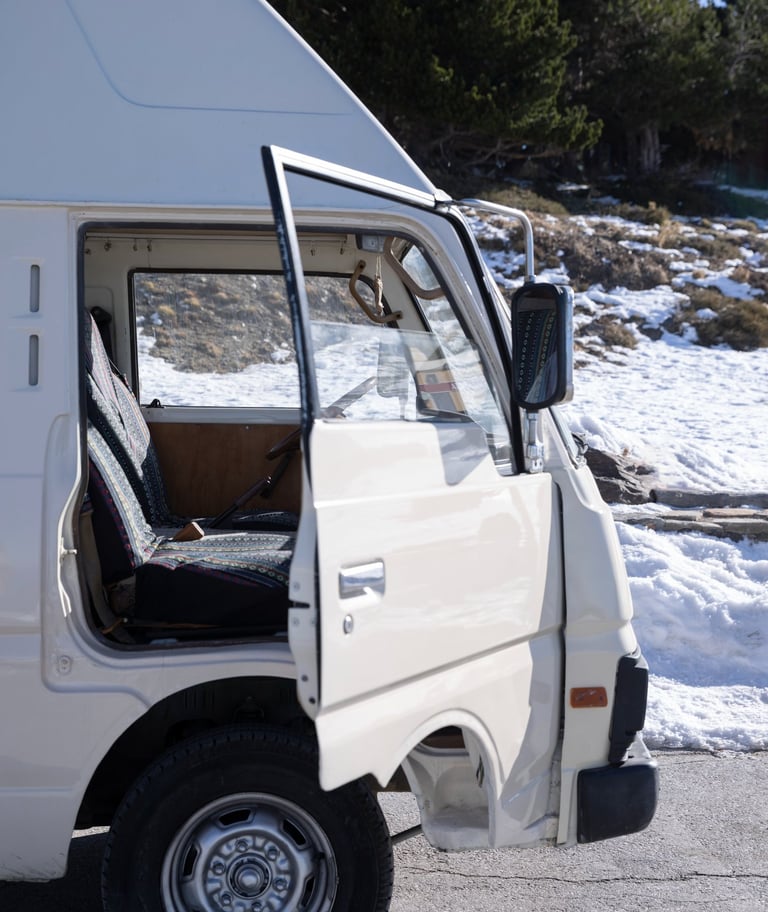Partition Walls in Campervan: Keep or Remove Them?
We explore the pros & cons of having Partition Walls in a campervan. If you're converting a van, it's important to understand how the wall impacts safety, temperature control & noise levels
1/15/20253 min read
Partition Walls in Campervans: Essential Barrier or Restrictive Choice?
In this article, we explore the pros and cons of having a partition wall in a campervan. Whether you're converting a van into a stealth camper or optimizing your current conversion, it's important to understand how the wall impacts safety, temperature control, and noise levels. We share experiences and insights from other campervan owners to help you make the best decision.
Converting a van into a campervan is an exciting journey that comes with a lot of decisions. One of the first questions is about layout: How do you make the most of the limited space? Striking a balance between functionality and comfort can be challenging, and deciding whether to keep or remove the partition wall is a key consideration. In this article, we’ll explore the pros and cons of keeping the wall. However, remember to check your local regulations and consult your insurance provider before making any structural changes.
Campervan Layout – Where to Start?
One of the first things you’ll think about when converting a van is the layout. It’s a fun process, but with limited space and so many possibilities, it often involves compromises. Deciding whether to keep the partition wall is a crucial part of this process.
Can You Remove the Partition Wall in a Van?
In the UK, there is no legal requirement to keep the partition wall in most vans. The key rule is that anything inside the vehicle's cabin must be securely fixed. If you plan to register your van as a motor caravan (or campervan), you must be able to move freely between the cab and the living area. This usually requires removing or modifying the partition wall.
For most modern vans, removing the wall is entirely possible and can make the space more liveable. However, some exceptions exist. For example, older vans registered in the 1980s may have specific conditions requiring the wall to remain intact.
So, if the regulations allow it, grab your tools and get started! 🛠️


Fördelar med att behålla skiljeväggen
Safety: A partition wall prevents loose objects from flying into the cab during sudden stops or accidents, offering additional protection for passengers.
Temperature Control: It helps maintain temperature in the living area by separating it from the less insulated cab, particularly during winter.
Noise Reduction: A partition dampens road noise, creating a quieter driving experience.
Privacy: The wall provides separation, making the living area feel more private—especially useful when travelling with others.
Extra Storage: Partition walls can serve as mounting points for shelves or cabinets, maximising storage space.
Stable Mounting for Equipment: Walls offer a sturdy surface for attaching equipment like heaters, fridges, or electronics without worrying about them loosening during transit.
Structural Support: The wall can increase the vehicle's stability and help secure the living area during movement.
Cons of Keeping the Partition Wall
Restricted Openness: Removing the wall creates a more open and airy feel, allowing free movement between the cab and living area.
Less Efficient Heating: While the wall aids temperature control, without it, heating the entire van can be challenging. However, solutions like insulated curtains or panels can mitigate this.
Limited Design Flexibility: Without the wall, you have more freedom to design a layout that better suits your needs and lifestyle.
Ventilation Issues: A partition can restrict airflow between the cab and living area, potentially leading to stuffiness.
Layout Constraints: In smaller vans, the wall can limit your ability to optimise the living space.
Extra Weight: Keeping the wall adds weight, which can affect fuel economy and handling.
Reduced Adaptability: Once in place, the wall makes future modifications to the interior more challenging.
Final Thoughts
Deciding whether to keep or remove the partition wall ultimately comes down to your individual needs and preferences. Both options have compelling arguments, so think carefully about how you plan to use your van.
In our own experience, we initially struggled with the wall's limitations for layout design. However, once we decided to keep it but modified it with a "window hatch" for light and ventilation, it made a noticeable difference. The added structure provided peace of mind during travel, knowing we had an extra layer of safety in case of an accident. Plus, once we fully insulated the walls and roof, the living area became cosy and quiet, even with the hatch open.
Before making your choice, always check local laws and regulations, as they can vary. By weighing the pros and cons, you can make an informed decision to customise your campervan perfectly for your style of adventure.


Guide
Your resource for camper van electrical systems.
Contact us
Support
© 2024. All rights reserved.
